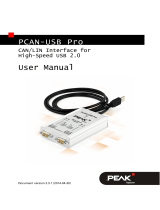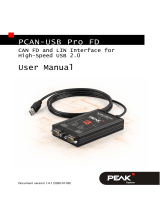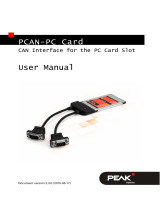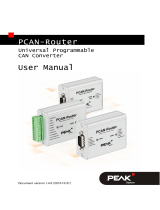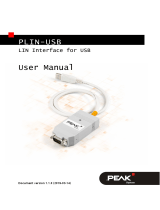Page is loading ...

PCAN-USB Pro
FD
CAN FD and LIN Interface for
High-Speed USB 2.0
User Manual
Document version 1.0.0 (2014-08-06)

PCAN-USB Pro FD – User Manual
2
Products taken into account
Product Name Model Part number
PCAN-USB Pro FD IPEH-004061
CANopen® and CiA® are registered community trade marks of CAN in Automation
e.V.
All other product names mentioned in this document may be the trademarks or
registered trademarks of their respective companies. They are not explicitly marked
by “™” or “®”.
© 2014 PEAK-System Technik GmbH
PEAK-System Technik GmbH
Otto-Roehm-Strasse 69
64293 Darmstadt
Germany
Phone: +49 (0)6151 8173-20
Fax: +49 (0)6151 8173-29
www.peak-system.com
info@peak-system.com
Documen
t version 1.0.0 (2014-08-06)

PCAN-USB Pro FD – User Manual
3
Contents
1 Introduction 5
1.1 Properties at a Glance 5
1.2 System Requirements 7
1.3 Scope of Supply 8
2 Installing the Software and the Adapter 9
3 Connecting the CAN and LIN Bus 11
3.1 D-Sub Connector CAN 11
3.2 D-Sub Connector LIN 12
3.3 Supplying External Devices via the D-Sub
Connector 13
3.4 CAN Termination 16
3.5 Cabling 18
3.5.1 Termination 18
3.5.2 Example of a Connection 18
3.5.3 Maximum Bus Length 18
4 Operation 20
4.1 Status LEDs 20
4.2 Unplugging the USB Connection 21
4.3 Distinguishing Several PCAN-USB Pro Adapters 21
5 Software and API 22
5.1 Monitor Software PCAN-View 22
5.1.1 Receive/Transmit Tab 24
5.1.2 Trace Tab 27
5.1.3 PCAN-USB Pro FD Tab 28
5.1.4 Bus Load Tab 29
5.1.5 Error Generator Tab 30
5.1.6 Status Bar 31

PCAN-USB Pro FD – User Manual
4
5.2 LIN Monitor PLIN-View Pro for Windows 32
5.2.1 Receive/Transmit or Receive/Publisher
Tab 34
5.2.2 Trace Tab 36
5.2.3 Status Bar 37
5.3 Linking Own Programs with PCAN-Basic 38
5.3.1 Features of PCAN-Basic 39
5.3.2 Principle Description of the API 40
5.3.3 Notes about the License 41
5.4 Linking Own Programs with the PLIN-API 42
6 Technical Specifications 44
Appendix A CE Certificate 46
Appendix B Dimension Drawing 47
Appendix C Quick Reference 48

PCAN-USB Pro FD – User Manual
5
1 Introduction
The PCAN-USB Pro FD adapter enables the connection of CAN FD
and LIN networks to a computer via USB. Two field busses can be
connected at the same time, up to four with appropriate adapter
cables (2 x CAN FD, 2 x LIN). Each CAN FD channel is separately
isolated against USB and LIN with a maximum of 500 Volts. Its
robust aluminum casing makes the PCAN-USB Pro FD adapter
suitable for mobile applications.
The new CAN FD standard (CAN with Flexible Data Rate) is
primarily characterized by higher bandwidth for data transfer. The
maximum of 64 data bytes per CAN FD frame (instead of 8 so far)
can be transmitted with bit rates up to 12 Mbit/s. CAN FD is
downward-compatible to the CAN 2.0 A/B standard, thus CAN FD
nodes can be used in existing CAN networks. However, in this case
the CAN FD extensions are not applicable.
Software interfaces exist for different operating systems, so
programs can easily access a connected CAN and/or LIN bus.
Tip: At the end of this manual (Appendix C) you can find a
Quick Reference with brief information about the installation
and operation of the PCAN-USB Pro FD adapter.
1.1 Properties at a Glance
Adapter for High-speed USB 2.0
(compatible to USB 1.1 and USB 3.0)
Transmitting and receiving of CAN FD and LIN messages using
2 D-Sub connections (both with pin assignment for CAN and
LIN bus)
Time stamp resolution 1 μs

PCAN-USB Pro FD – User Manual
6
5-Volt supply at the D-Sub connector can be activated through a
solder jumper, e.g. for external bus converter
Voltage supply via USB
Extended operating temperature range -40 - 85 °C (-40 - 185 °F)
CAN operation properties
Complies with CAN specifications 2.0A/B and FD 1.0
CAN FD bit rates for the data field (64 bytes max.) from 40 kbit/s
up to 12 Mbit/s
CAN bit rates from 40 kbit/s up to 1 Mbit/s
FPGA implementation of the CAN FD controller
NXP TJA1044GT CAN transceiver
Each CAN channel is separately opto-decoupled against USB
and LIN up to 500 V
CAN termination can be activated through a solder jumper
Measurements of bus load including error frames and overload
frames
Induced error generation for incoming and outgoing CAN
messages
LIN operation properties
Bit rates from 1 up to 20 kbit/s
TJA1021/22 LIN transceiver
Both LIN channels (common ground) are opto-decoupled
against USB and CAN
Can be used as a LIN master or slave (1 ms master task
resolution)
Automatic bit rate, frame length, and checksum type recognition

PCAN-USB Pro FD – User Manual
7
Autonomous scheduler with support for unconditional, event,
and sporadic frames
Hardware can work through a schedule table (up to 8 tables can
be configured with a total of 256 slots)
Note: This manual describes the use of the PCAN-USB Pro FD
with Windows. You can find CAN drivers for Linux and the
corresponding application information on the provided DVD in
the directory branch Develop and on our website under
www.peak-system.com/linux.
1.2 System Requirements
Operating system Windows 8.1, 7, Vista (32/64-bit)
or Linux (32/64-bit)
A vacant USB port (USB 1.1, USB 2.0 or USB 3.0 ) at the
computer or at a USB hub connected to the computer
For LIN operation: supply voltage 8 to 18 V for the LIN
transceiver (e.g. car battery)
Note: Do not use a USB extension cable to connect the PCAN-
USB Pro FD adapter to the computer. The use of an extension
cable does not comply with the USB specification and can lead
to malfunction of the adapter.

PCAN-USB Pro FD – User Manual
8
1.3 Scope of Supply
PCAN-USB Pro FD in aluminum casing
CAN FD interface drivers for Windows 8.1, 7, Vista
and Linux (32/64-bit)
LIN interface drivers for Windows 8.1, 7, Vista (32/64-bit)
PCAN-View monitor software for Windows 8.1, 7, Vista
(32/64-bit)
PLIN-View Pro LIN monitor for Windows 8.1, 7, Vista, (32/64-bit)
PCAN-Basic programming interface consisting of an interface
DLL, examples, and header files for all common programming
languages
PLIN-API programming interface consisting of an interface DLL,
an example, and header files for all common programming
languages
Manual in PDF format
Note: Since the application possibilities of the PCAN-USB Pro
FD adapter are various, special cable adapters for connecting
the CAN and LIN busses are not provided. Therefore you need
a 9-pin D-Sub female connector for your appliances to be
connected individually.

PCAN-USB Pro FD – User Manual
9
2 Installing the Software and
the Adapter
This chapter covers the software setup for the PCAN-USB Pro FD
adapter under Windows and the connection of the adapter to a
computer.
Setup the drivers before
connecting the PCAN-USB Pro FD adapter
to the computer for the first time.
Do the following to install the drivers:
1. Insert the supplied DVD into the appropriate drive of the
computer. Usually a navigation program appears a few
moments later. If not, start the file Intro.exe from the root
directory of the DVD.
2. Select in the main menu Drivers, and then click on the
bottom right Install now.
3. Confirm that changes may be done on your computer or get
administrator rights.
4. Select the suitable installation type for you.
5. Click on Installation or Next. The setup program for the
driver is executed.
6. Follow the instructions of the program.

PCAN-USB Pro FD – User Manual
10
Do the following to connect the PCAN-USB Pro FD adapter to
the computer and complete the initialization:
Note: Do not use a USB extension cable to connect the PCAN-
USB Pro FD adapter to the computer. The use of an extension
cable does not comply with the USB specification and can lead
to malfunction of the adapter.
1. Connect the PCAN-USB Pro FD adapter to a USB port at the
computer. The computer can remain powered on.
Windows notifies that new hardware has been detected.
2. The drivers are found and installed by Windows.
3. Afterwards you can work as a user with restricted rights
again.
After a successful initialization of the drivers for the CAN and the
LIN bus the LEDs on the PCAN-USB Pro FD are green.
After the driver has been successfully set up you can find the
“PCAN-USB Pro FD” entry in the “CAN-Hardware” branch of the
Windows Device Manager.

PCAN-USB Pro FD – User Manual
11
3 Connecting the CAN and LIN
Bus
Both D-Sub connectors on the PCAN-USB Pro adapter are each
used for connecting one CAN and one LIN bus. The pin assignment
is identical for both D-Sub connectors.
Note: Since the application possibilities of the PCAN-USB Pro
adapter are various, special cable adapters for connecting the
CAN and LIN busses are not provided. Therefore you need a
9-pin D-Sub female connector for your appliances to be
connected individually.
3.1 D-Sub Connector CAN
Two High-speed CAN busses (ISO 11898-2) can be connected, one
to each D-Sub connector. The pin assignment for CAN corresponds
to the specification CiA® 102.
Figure 1: CAN pin assignment of the D-Sub connector
Each CAN connection separately has a galvanic isolation up to
500 V against USB and LIN.

PCAN-USB Pro FD – User Manual
12
Tip: You can connect a CAN bus with a different transmission
standard via a bus converter. PEAK-System offers different bus
converter modules (e.g. PCAN-TJA1054 for a Low-speed CAN
bus according to ISO 11898-3).
3.2 D-Sub Connector LIN
Two LIN busses can be connected, one to each D-Sub connector.
Figure 2: LIN pin assignment of the D-Sub connector
For the LIN operation an additional supply voltage must be applied
to pin Vbat-LIN (8 - 18 V DC, e.g. car battery). Both LIN connections
need their own supply.
Both LIN connections have a common galvanic isolation up to 500 V
against USB and CAN. The LIN connections are not
galvanically
isolated against each other.

PCAN-USB Pro FD – User Manual
13
3.3 Supplying External Devices via the
D-Sub Connector
On the circuit board of the PCAN-USB Pro FD adapter (casing
opened) a 5-Volt supply can optionally be routed to pin 1 of each
D-Sub connector. At delivery this pin is not assigned.
Figure 3: External 5-Volt supply at the D-Sub connectors
When using this option the 5-Volt supply is connected to the power
supply of the computer and is not fused separately. A DC/DC con-
verter is interconnected. Therefore the current output is limited to
50 mA.
Tip: On request we deliver the device configured with this
option.
Proceed as follows to activate the 5-Volt supply:
Attention! Electrostatic discharge (ESD) can damage or destroy
components on the PCAN-USB Pro FD board. Take precautions
to avoid ESD when handling the card.
1. Remove the three screws at the back of the casing.

PCAN-USB Pro FD – User Manual
14
2. Remove the two outer screws next to the D-Sub connectors
at the front of the casing.
3. Remove the casing cover.
4. Lift the back of the case and slide the circuit board in
direction of the front over the lower part of the casing. The
bottom of the circuit board is accessible now.
Set the solder bridge(s) on the circuit board of the PCAN-
USB Pro FD adapter according to the desired function.
During this procedure take especially care not to produce
unwanted short circuits on the board.
The following figure shows the positions of the solder fields JP4
and JP7 on the circuit board of the PCAN-USB Pro FD adapter; the
table below contains the possible settings.

PCAN-USB Pro FD – User Manual
15
Figure 4: Top view PCAN-USB Pro FD board,
solder fields JP4/JP7
5-Volt supply →
None Pin 1
CAN1, solder field JP4
CAN2, solder field JP7
After you have done the settings, reassemble the device. Slide the
circuit board back into the lower part of the casing, close the casing
cover, and screw the front and back side.
Attention! Risk of short circuit! If the option described in this
section is activated, you may only connect or disconnect CAN
cables or peripheral systems (e.g. external bus converters) to or
from the PCAN-USB Pro FD while it is de-energized (the PCAN-
USB Pro FD adapter is not connected to the computer).
Consider that some computers still supply the USB ports with
power even when they are turned off (standby operation).

PCAN-USB Pro FD – User Manual
16
3.4 CAN Termination
The termination can be activated by solder jumpers for each
channel on the board. At delivery the termination is not activated. A
High-speed CAN bus (ISO 11898-2) must be terminated on both
ends with 120 Ohms. Otherwise disturbances may arise. If a CAN
bus is not terminated correctly, activate the internal termination.
To activate the termination, two solder jumpers must be
soldered for each channel. Proceed as follows to activate the
termination:
Attention! Electrostatic discharge (ESD) can damage or destroy
components on the PCAN-USB Pro FD board. Take precautions
to avoid ESD when handling the card.
1. Remove the three screws at the back of the casing.
2. Remove the two outer screws next to the D-Sub connectors
at the front of the casing.
3. Remove the casing cover.
4. Lift the back of the case and slide the circuit board in
direction of the front over the lower part of the casing. The
bottom of the circuit board is accessible now.

PCAN-USB Pro FD – User Manual
17
Set the solder bridges on the circuit board of the PCAN-USB
Pro FD adapter to activate the termination. During this
procedure take especially care not to produce unwanted
short circuits on the board.
Figure 5 shows the positions of the solder fields JP1 and JP2 for
CAN 1 and JP5 and JP6 for CAN 2 for the termination.
Figure 5: Top view PCAN-USB Pro FD board,
solder fields JP1/JP2 and JP5/JP6
After you have done the settings, reassemble the device. Slide the
circuit board back into the lower part of the casing, close the casing
cover, and screw the front and back side.

PCAN-USB Pro FD – User Manual
18
3.5 Cabling
3.5.1 Termination
A High-speed CAN bus (ISO 11898-2) must be terminated on both
ends with 120 Ohms. Otherwise, there are interfering signal
reflections and the transceivers of the connected CAN nodes (CAN
interface, control device) will not work.
The PCAN-USB Pro FD adapter has a switchable internal termina-
tion (see section 3.4 on page 16). If a CAN bus is not terminated
corr
ectly, activate the internal termination.
3.5.2 Example of a Connection
Figure 6: Simple CAN connection
In this example, the PCAN-USB Pro FD adapter is connected with a
control unit by a cable that is terminated at both ends.
3.5.3 Maximum Bus Length
High-Sp
eed-CAN networks may have bit rates of up to 1 Mbit/s. The
maximum bus length depends primarily on the bit rate.
The following table shows the maximum possible CAN bus length
at different bit rates:

PCAN-USB Pro FD – User Manual
19
Bit rate Bus length
1 Mbit/s 40 m
500 kbit/s 110 m
250 kbit/s 240 m
125 kbit/s 500 m
50 kbit/s 1.3 km
The listed values have been calculated on the basis of an idealized
system and can differ from reality.
The dependency of the bus length of the transmission rate is based
on the arbitration phase of CAN communication. For CAN FD the
transmission rate of arbitration is determined by the nominal bit
rate. Through this can only take a maximum value of 1 Mbit/s, apply
for CAN FD the same maximum bus lengths as for CAN, despite the
higher data transfer.

PCAN-USB Pro FD – User Manual
20
4 Operation
4.1 Status LEDs
For indication of operating conditions the PCAN-USB Pro FD
adapter has several LEDs.
Figure 7: Layout of the LEDs on the casing
LED Status Meaning
Green on A High-speed USB connection (USB 2.0) with a
computer is established.
Green blinking Communication is occurring on the High-speed
USB connection (USB 2.0).
A Full-speed USB connection (USB 1.1) with a
computer is established.
Orange on
The PCAN-USB Pro FD adapter is in suspend
mode (only voltage supply via USB cable, e.g.
during computer standby).
USB
Orange blinking Communication is occurring on the Full-speed
USB connection (USB 1.1).
/
